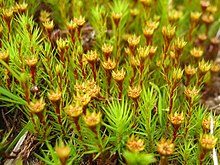Polytrichum
| Polytrichum | |
|---|---|

| |
| Male antheridia
| |
| Scientific classification | |
| Kingdom: | Plantae |
| Division: | Bryophyta |
| Class: | Polytrichopsida |
| Order: | Polytrichales |
| Family: | Polytrichaceae |
| Genus: | Polytrichum Hedw. |
Polytrichum is a genus of mosses — commonly called haircap moss or hair moss — which contains approximately 70 species that have a cosmopolitan distribution. The genus Polytrichum has a number of closely related

Appearance
Haircap moss gets its name from the hairs that cover, or cap, the calyptra where each spore case is held (1). Looking down, haircap moss has a star-shaped appearance due to its pointed leaves arranged spirally at right angles around a stiff stem (3). It is generally dark green in color and grows 4 – 20 cm tall. The average life span of this moss is three to five years, though the longest have lived up to ten, and the moss can remain intact for long periods after dead.
Physiology
Mosses in the genus Polytrichum are endohydric, meaning water is conducted from the base of the plant. While mosses are considered
Another characteristic feature of the genus is its parallel
Polytrichum species are
Classification
The genus
Species
- Polytrichum appalachianum[7]
- Polytrichum alpinum[8]
- Polytrichum commune
- Polytrichum formosum[8]
- Polytrichum hyperboreum[7]
- Polytrichum juniperinum[8][1]
- Polytrichum longisetum[8]
- Polytrichum lyallii[7]
- Polytrichum ohioense[7]
- Polytrichum pallidisetum[7]
- Polytrichum papillatum[7]
- Polytrichum piliferum[8]
- Polytrichum sexangulare[7]
- Polytrichum sphaerothecium[7]
- Polytrichum strictum
- Polytrichum swartzii[7]
References
- ^ Smith Merrill, Gary L. (2007), "Polytrichum", Flora of North America, vol. 27, Oxford University Press
- ISBN 0-231-04516-6
- ^ a b Silverside, A.J. (2005), Biodiversity Reference: Polytrichum commune Hedw., University of Paisley, archived from the original on 2005-12-28, retrieved 2008-02-16
- ^ PMID 21622419.
- ^ 1. Polytrichastrum G. L. Smith, Flora of North America
- PMID 20152915.
- ^ a b c d e f g h i Polytrichum, USDA PLANTS
- ^ a b c d e BLWG Verspreidingsatlas Mossen online (in Dutch)
